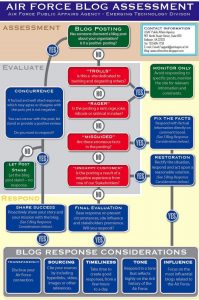There are a lot of trolls out there. Trolls are people that anonymously post incendiary comments to online articles and blogs just for the sake of picking a fight. Mixed in with these agitators are real people who are frustrated and genuinely upset with the company that deserve a response.
Sometimes it’s hard to know when you should respond to a comment, or when to simply to ignore it and not take the bait.
One way to decide is to do what the Air Force does. And no, I’m not suggesting adoption of a scorched Earth policy.
Several years ago, the Air Force created a Blog Assessment chart for its spokespeople advising when and how to respond, or ignore, to blogs and comments. The image (shown here) is still an excellent flow chart that works today for blogs and social media.
In addition to this flow chart, there are lots of online guides of how to respond to comments or complaints via social media. The most important thing you need to remember is that your job is to promote your organization in a positive light. You’re there to defuse a negative situation, not to make it worse your actions (or lack of actions). Here are a few tips to get you started.
- Don’t delete negative comments. All it does is make people angrier—the person who posted the comment and the people who noticed what the poster said.
- Ignore the Instigators. If the comment is clearly an attack solely designed to pick a fight, ignore it. Readers will see past the bully and will appreciate that you’re focused on responding to legitimate comments. The bullies will get bored and look for someone else willing to engage in a back-and-forth war of words.
- Block When Warranted. If someone posts racist, derogatory or pornographic comments about your company or staff, that commenter should be blocked so that they can’t comment on future posts.
- Keep Calm. Any response you give will be read not only by the poster, but by other readers/followers including potentially the media. You want to always appear positive, helpful, and level headed in any response.
- Respond Quickly. The faster your response, the more people believe that you genuinely want to do what’s right to fix any concerns. We’re talking within an hour when possible, not days. The longer it takes you to respond the less engaged and interested you seem.
- Respond to Negative Comments So That Everyone Can See that You Responded. Within public view, acknowledge the comment and then try to take conversations off-line. A simple message such as “Thanks for bringing this to our attention. Would you email me directly so that I can learn more?” After you resolve the problem off-line, return to public view and say something like “Thanks for connecting with me off-line. Hopefully we were successful in resolving your concerns.”
- Acknowledge Positive Comments So That Everyone Can See You Responded. A simple thank you for a compliment or stating that you’ll pass the comment on to co-workers goes a long way towards encouraging more positive comments to be posted.
- Save a Copy. Occasionally social media discussions become part of legal disagreements. If you think a legal issue or accusation may arise, alert your legal counsel immediately and take a screen shot and save a copy of incendiary remarks before they can delete or modify their posts or comments. If the incident becomes a legal matter, you may want to have a paper trail before it’s lost from view.
Think of it this way. If someone called your office to complain, you’d try to fix their problem. When someone posts their problem online, you still need to fix the problem. Only now there’s lots of people watching to see how you fix it. Approach the solution in a way that makes you look genuine and honest, and it’ll win you more customers and support.
